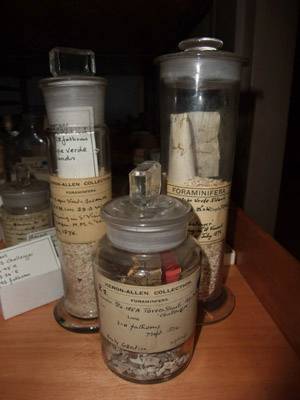Ocean acidification is one of the major effects of increased carbon dioxide levels in the atmosphere caused by the burning of fossil fuels (coal, oil, gas). Museum collections of samples from the ocean bottom worldwide are housed at our Wandsworth outstation and are vital to working out how much more acidic the oceans have become since the 19th Century and to helping create models for future changes.
Three bottles of ocean sediment collected in 1891 as part of the H.M.S. Penguin cruise to the Mediterranean
Our outstation at Wandsworth holds the Mineralogy Department's Ocean Bottom Sediment Collection. These are sediment samples from many cruises including the first oceanographic voyage the Challenger Expedition of 1872-1876. I mentioned previously that we hold residues including microfossils at South Kensington so why are these bottles of sediment at Wandsworth of interest to micropalaeontologists?
Potentially these bottles contain many thousands of microfossils (the ones above mention the foraminferal genus Globigerina) and as a result, they have been of interest for two PhD students studying the effects of ocean acidification on micro-organisms.
Open University PhD student Kate Salmon accessing the Ocean Bottom Sediment Collection at the Museum outstation at Wandsworth. Curator Dave Smith is in the background.
Kate Salmon is using mainly foraminiferal microfossils to measure the scale of ocean acidification in the area around Bermuda. To do this she is studying samples collected every 2 weeks for the past 20-30 years in sediment traps on the ocean bottom.
The weights and shell thicknesses of these micro-organisms that use the ocean water to produce their shells of calcium carbonate should be different in pre-industrial samples. If ocean acidification is happening we should see lighter more fragile shells in the present day. Kate is using the Ocean Bottom Sediment Collection at the Museum to find comparative material from pre-industrial times.
Kate recently told me, 'If I do the same shell analyses on these samples, it will give a good comparison of low carbon dioxide conditions with higher carbon dioxide conditions (present day) and I will be able to see how conditions have changed for the calcifying biology of the oceans. I can then use these results to predict any future changes in the calcification of foraminifera and the implications this will have for other creatures living in the water column'.
Part of the residue collection from the H.M.S. Penguin expedition collected in 1891.
Ella Howes, a student at the Laboratoire d'Océanographie de Villefranche sur Mer, France approached us to see if we had any sediment including the remains of tiny organisms called pteropods. These are small planktonic gastropods (floating snails) that have been used extensively in ocean acidification studies. Ella has recent material from near Bear Island in the Mediterranean and wants to compare the composition and structure of these faunas prior to major industrial activity.
She is searching for a particular pteropod species Limacina helicina as well as foraminifera. As with Kate Salmon, she is looking to make measurements of shell thickness to assess possible outcomes of ocean acidification between the Mediterranean and colder water areas.
'In Polar regions the cold temperatures allow increased carbon dioxide in water, potentially causing more extreme repercussions for animals living in these areas. A geographical comparison between the effects on ocean acidification on shell thickness in Polar pteropods and the warmer Mediterranean Sea will be undertaken using modern samples of Limacina helicina and old sediment samples provided by the Natural History Museum' says Ella.
Part of one of four rows of cabinets containing the Ocean Bottom Sediment Collection at the Museum.
When you consider the quantity of material at our Wandsworth outstation, there is limitless potential for similar studies to be carried out. There are literally millions of micro-organsims from the ocean bottom waiting to be studied. Listings of these collections can be found on the Museum web site. In the meantime, I will wait with interest to hear from Kate and Ella if a trip to Wandsworth can help quantify ocean acidification.




